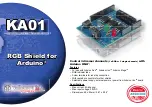
Clock & reset system
RM0082
204/844
Doc ID 018672 Rev 1
The Memory controller use the HCLK to synchronize the internal bus access and the other
clock, that can be chosen from PLL1 or PLL2 (Misc register setting), is used on the external
memory Interface. Two clock domains can be synchronous or asynchronous. In example we
can have the CPU running at 333 MHz and the HCLK bus running at 166 MHz but having
the external DDR memory running at 266 MHz to reduce the board cost. In this example the
PLL1 will provide the clock to all the internal blocks (CPU and bus) while PLL2 will provide
the frequency to the external memory. Having the two clock domain asynchronous offer
more flexibility in the system definition but also add some more latency due to the
resynchronization stages.
11.2.3 Bus
clocks
Through the misc CORE_CLK_CFG, PRPH_CLK_CFG register is possible to define the
ratio between the CPU clock and its HCLK, the ratio between the AHB and the APB clock,
and also the source for the peripheral clock. Typically (default value) this is derived from the
fixed frequency of 48 MHz avoiding any setting problem when the bus clock change value
because of different system state or because of different PLL setting. Some other register
offer also the possibility to enable or disable the clock for each peripheral allowing a
sophisticated power management.
11.2.4
Configurable logic clock
The RAS block contains SDIO, Telecom, FSMC and CLCD IPs that are working at AHB
frequency. Keyboard and ARM GPIO blocks are working with APB clock frequency.
Figure 16.
RAS block diagram
CLCD
SDIO
TELECOM
(Voice)
KEYBOARD
TELECOM
(Camera)
ARM GPIO
HCLK
ClkR_48MHz
HCLK
ClkR_48MHz
FSMC
HCLK
PCLK
PCLK
ClkR_48MHz
HCLK
ClkR_Pll2
ClkR_Synt2
ClkR_Synt3
Clk_Osci1
I2S
RAS_R_GPIOCLK_in[3]
RAS_R_GPIO_in[40]
RAS_R_GPIO_in[35]
















































